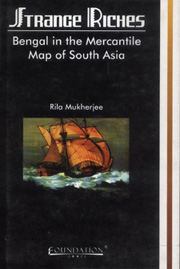Book contents
- Frontmatter
- Contents
- Epigraph
- Preface
- Acknowledgments
- Abbreviations
- Map 1 Places mentioned in Bengal and Arakan: 5th to 13th centuries
- Map 2 Land and sea routes of the Eastern Indian Ocean: 13th to 15th centuries
- 1 Introduction
- 2 Conceptual Formulations
- 3 Key Issues: Bengal
- 4 Introducing Bengal
- 5 The Debated Century
- 6 Networks and States in South Asia
- 7 Unities of Time and Space in Bengal
- 8 Bengal in the Indian Ocean Centred World Economy
- 9 Conclusion
- Bibliography
- Index
1 - Introduction
Published online by Cambridge University Press: 26 October 2011
- Frontmatter
- Contents
- Epigraph
- Preface
- Acknowledgments
- Abbreviations
- Map 1 Places mentioned in Bengal and Arakan: 5th to 13th centuries
- Map 2 Land and sea routes of the Eastern Indian Ocean: 13th to 15th centuries
- 1 Introduction
- 2 Conceptual Formulations
- 3 Key Issues: Bengal
- 4 Introducing Bengal
- 5 The Debated Century
- 6 Networks and States in South Asia
- 7 Unities of Time and Space in Bengal
- 8 Bengal in the Indian Ocean Centred World Economy
- 9 Conclusion
- Bibliography
- Index
Summary
Bengala, a most spacious and fruitful province, but more properly to be called a kingdom, which hath two very large powers in it, Purb and Patan, the one lying in the east, the other on the west side of the river Ganges… the chief cities in it are Ragamahat and Dakaka. It hath many havens and ports belonging unto it, which are places of very great trade. (Edward Terry, Voyage to East India, London, T. Wilkes, MDCC LXXVIII: 84–5)
My interest in Bengal's commercial history from the early to the late medieval period is a by product of the doctoral thesis on trade and merchants in eighteenth century Kasimbazar that I did under the supervision of the late Professor Denys Lombard at the Ecole des Hautes Etudes en Sciences Sociales, Paris; a work that was made possible through a French Government doctoral grant from 1981–1985. This was published in 2006 as Merchants and Companies in Bengal: Kasimbazar and Jugdia in the Eighteenth Century, New Delhi, Pragati Publications. At the time, notions of ‘Asian Trade’ and ‘successor states’ dominated academic studies on eighteenth century South Asian history. Both notions displayed a deliberate and genuine attempt to understand the pre-colonial period and the nature of transformations in the colonial period. A debate that held centrestage at this time was whether (or not, as the case may be) the seeds of capitalism were present in seventeenth century South Asia.
- Type
- Chapter
- Information
- Strange RichesBengal in the Mercantile Map of South Asia, pp. 1 - 20Publisher: Foundation BooksPrint publication year: 2006



